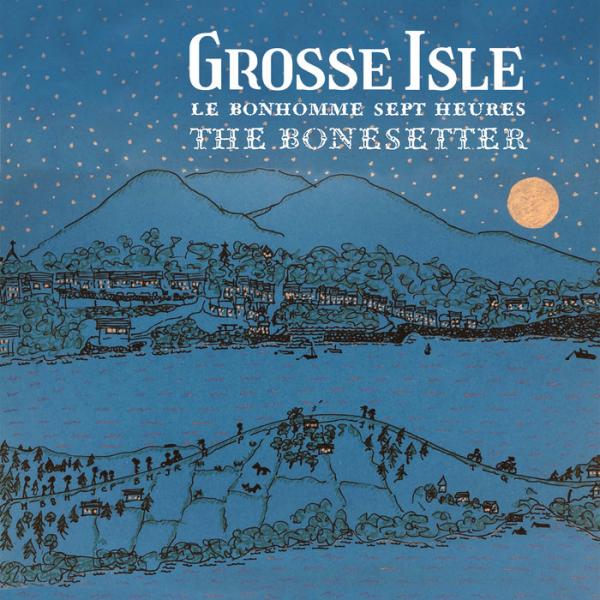November 1, 2021

Grosse Isle, “Le Bonhomme Sept Heures/The Bonesetter”
The name “Grosse Isle” is a reference to one of the innumerable stories woven into the Irish Diaspora. Located in the St. Lawrence River in Quebec, Grosse Isle was a way station – and all too often a final resting place – for Irish fleeing the Great Famine. In fact, it’s the largest burial ground outside of Ireland for famine refugees, and there is a national historic memorial site on the island.
But despite the tragic association, Grosse Isle is also suggestive of the ties between Irish and Quebecois culture, particularly as regards music. That’s the raison d'être of this trio, which comprises Connemara native Fiachra O’Regan (uilleann pipes, banjo, whistle) and Quebec musicians Sophie Lavoie (fiddle, piano, vocals) and André Marchand (guitar, foot percussion, vocals). A quick bit of history: O’Regan and Lavoie began performing as a duo 13 years ago, becoming a trio named Fásta with guitarist Michael McCague (a past member of Téada), who was succeeded by Marchand; the O’Regan-Lavoie-Marchand combo released one album as Fásta and another without a band name, before choosing Grosse Isle as its nom d’groupe.
In any event, "Le Bonhomme Sept Heures" is arguably the trio's finest effort in integrating Irish and Quebecois music, which have modest but hardly insignificant differences, such as in ornamentation (more rolls and cuts for Irish, more triplets for Quebecois) and the tendency in Quebecois toward "crooked" tunes, with beats added or removed from the natural phrases of 16 beats. Suffice it to say, Grosse Isle captures both the drive of Irish and the gallop (and joie de vivre) of Quebecois. Wisely, they don’t try to graft the music traditions together excessively or unnecessarily, but instead look for, and craft, opportunities for them to complement one another.
A particularly well-put-together set of reels begins with pipes and fiddle having a go at “Jack Caughlan’s,” then switching to pipes and guitar for “Miss Langford,” before Lavoie strikes up “Jack the Lad” – which happens to be the Quebecois version of the Irish “Five Mile Chase.” O’Regan takes up the tune on pipes, and with Marchand’s outstanding foot percussion – a delightfully infectious hallmark of Quebecois music – plus a guest appearance on bones by Jacques Landry, the effect is marvelous. One of the album’s best tracks, and best Irish-Quebec fusions, is the song “Les Tailleurs de Pierre,” with guest singer Michel Faubert (once with the mighty Quebecois ensemble La Bottine Souriante) alongside O’Regan’s pipes and Lavoie’s fiddle: Intermittently, the pair play the melody – reminiscent of “Sweet Betsy from Pike” – as a jig before shifting back to the song's 3/4 time signature.
All three deserve attention, and praise, for their musicianship, but it's hard not to single out Lavoie. In many ways, she's the linchpin here, since she plays both Irish- and Quebecois-style fiddle. She's also versatile on piano: Listen to her flat-out gorgeous mix of accompaniment and lead on that quintessential Irish air, “Ned of the Hill (Éamonn an Chnoic),” with O’Regan’s equally exquisite pipes. The very next track, she shifts to steady, dependable oom-chuck rhythm on a pair of reels, “Johnny Laughran’s/McKenna’s," and on Quebecois fiddler Claude Methé's "Calamine" – which follows "Patsy Campbell's Reel" – she matches O'Regan note for note and throws in some nifty bass runs as well. Her singing voice is mellow and relaxed, but quite capable of tackling the up-tempo numbers, such as "Je Veux M'y Marier" and the cautionary tale "Dedans Paris," the latter of which includes a fine vocals-pipes duet with O'Regan (who might be the originator of a Quebecois uilleann pipes style).
Lavoie also demonstrates her credentials as tunesmith and songwriter, including the two tunes which make up the album’s title track. Her piece de resistance is her haunting “À Grosse Isle,” which tells of Sarah MacDonald, who survived the wreck of the famine ship Carricks off the coast of Gaspé near Grosse Isle – but, unimaginably, lost five daughters.
Please, however, don't overlook Marchand, a mainstay of Quebec music for decades, as co-founder of the aforementioned La Bottine Souriante as well as the groundbreaking a cappella quintet Les Charbonniers de l’Enfer (Faubert also is a member), among many other achievements. His warm, folksy voice takes center stage on "Dans Paris à L'Orient" and harmonizes with Lavoie on the chorus of "Le Bonhomme et la Bonne Femme." Most of all, his justly praised guitar accompaniment – highly influential in Quebecois trad circles – is at the core of Grosse Isle's sound, and not just the quick-paced instrumentals, as his spare, sensitive backing on “À Grosse Isle” demonstrates.

